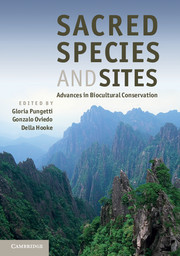Book contents
- Frontmatter
- Contents
- List of Contributors
- Foreword
- Preface
- Acknowledgements
- Introduction
- Part I Concepts and Knowledge
- 1 Sacred species and sites: dichotomies, concepts and new directions in biocultural diversity conservation
- 2 Spiritual values and conservation
- 3 Protected areas and sacred nature: a convergence of beliefs
- 4 Ancient knowledge, the sacred and biocultural diversity
- Part II Sacred Landscapes
- Part III Sacred Sites and People
- Part IV Sacred Species
- Part V Sacred Animals
- Part VI Sacred Groves and Plants
- Part VII Implementation and Conclusions
- Index
- Plate Section
- References
1 - Sacred species and sites: dichotomies, concepts and new directions in biocultural diversity conservation
from Part I - Concepts and Knowledge
Published online by Cambridge University Press: 05 August 2012
- Frontmatter
- Contents
- List of Contributors
- Foreword
- Preface
- Acknowledgements
- Introduction
- Part I Concepts and Knowledge
- 1 Sacred species and sites: dichotomies, concepts and new directions in biocultural diversity conservation
- 2 Spiritual values and conservation
- 3 Protected areas and sacred nature: a convergence of beliefs
- 4 Ancient knowledge, the sacred and biocultural diversity
- Part II Sacred Landscapes
- Part III Sacred Sites and People
- Part IV Sacred Species
- Part V Sacred Animals
- Part VI Sacred Groves and Plants
- Part VII Implementation and Conclusions
- Index
- Plate Section
- References
Summary
Introduction
This chapter aims to introduce the topics of this volume and to provide the reader with keywords and works of reference for the understanding of the complex subject addressed.
First, it explains dichotomies such as: biological and cultural diversity; nature and culture; sciences and humanities; mind and soul; tangible and intangible values; divine and animistic views.
First, it explains dichotomies such as: biological and cultural diversity; nature and culture; sciences and humanities; mind and soul; tangible and intangible values; divine and animistic views.
Second, it illustrates key concepts for the sacred dimension of biocultural diversity, offering a broad comprehension of meanings and definitions on the precise topics and those related to them.
Third, it outlines the state of the art and new directions in the conservation of biocultural diversity, taking into account sacred species and sites.
Dichotomies
Conservation of biodiversity is one of the challenges of our century and in situ conservation is a strategy to achieve it (Harmon and Putney, 2003, p. 3). Biocultural diversity relates largely to intangible values, which tend to be referred to as the enrichment of intellectual, psychological, emotional, spiritual, cultural and artistic aspects of well-being. Although these values contrast with the Western tendency to base knowledge on scientific and technical evidence, and economic and tangible criteria, intangible values are increasingly being recognised (UNESCO, 1998, 2002; Makhzoumi and Pungetti, 1999; Posey, 1999; Oviedo et al., 2000; Maffi, 2001; Lee and Schaaf, 2003; Schaaf and Lee, 2006; Persic and Martin, 2008).
- Type
- Chapter
- Information
- Sacred Species and SitesAdvances in Biocultural Conservation, pp. 13 - 27Publisher: Cambridge University PressPrint publication year: 2012
References
- 5
- Cited by



